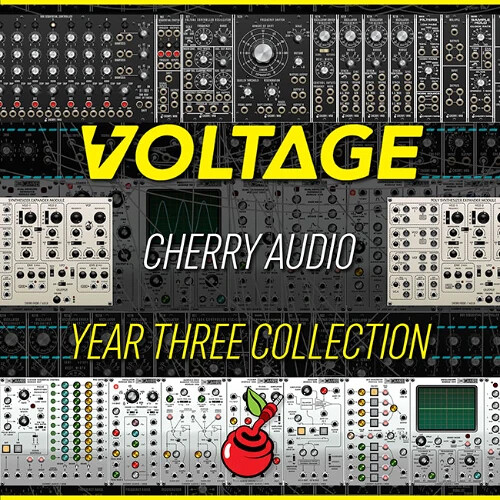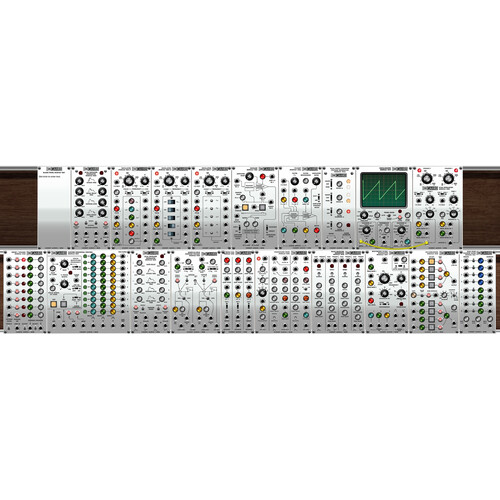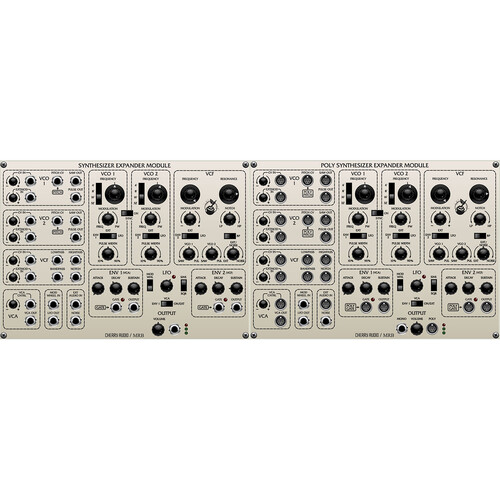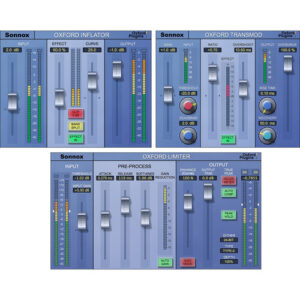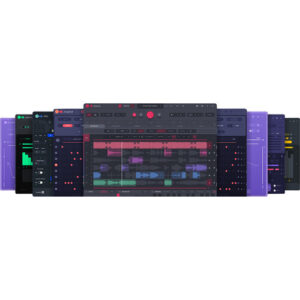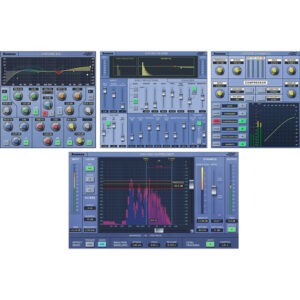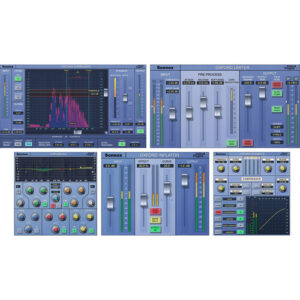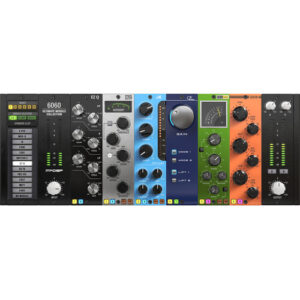MMS: 869 •
MPN: CA-11 •
SKU: 1316-1030
Cherry Audio Year Three Collection Modules for Voltage Modular Virtual Synthesizer (Download)
Authorized Dealer
In Stock
$129.00
100 in stock
Features
• Virtual Modules + Preset Library
• For Free Voltage Modular Software
• Classic Analog Synthesizer Emulations
• Synthesizer Expander Module
Description
The Year Three Modules Bundle from Cherry Audio is a collection of high-end modules for Voltage Modular that were introduced during the third year the virtual-modular synthesizer platform was available—offered at a substantial savings over the individual purchase prices. The set includes the Synthesizer Expansion Module and Poly Synthesizer Expansion Module, both of which emulate the venerable Oberheim Expander Module (aka SEM). The included VM2500 Collection emulates the legendary ARP 2500 synth, while the VM900 Collection recreates the Moog 900 series modules. A library of presets is provided to jump-start your creative process. The Voltage Modular software (available as a free download) runs on Mac and Windows computers as a plug-in or standalone instrument.
VM900 1630 Frequency Shifter
The VM1630 is a super-accurate recreation of the vintage Moog/Bode 1630 Frequency Shifter. A frequency shifter is an audio modifier that shifts the entire frequency spectrum of a signal by a given amount. The VM1630 can shift the spectrum up or down by up to 5000 Hz, and the downshifted and upshifted signals are simultaneously available. The shift amount and regeneration controls are fully voltage controllable.
VM900 900-1 Blank Panel
VM900 900-1 is a single space blank panel with a custom text field for adding comments, notes, etc.
VM900 900-2 Blank Panel
VM900 900-2 is a dual-space blank panel with a custom text field for adding comments, notes, etc.
VM900 901 Oscillator
The VM901 is a full-function oscillator module. It can be used in the audio range, or as a low-frequency modulation source. It accurately replicates the sound of the earliest Moog oscillator design.
VM900 901ABBB Oscillator
The VM901ABBB is an oscillator bank that replicates the unique oscillator controller/slave arrangement of classic Moog synthesizers. The concept is that the Oscillator Controller module sets the overall coarse tuning as well as rectangular wave pulse width for the three slave oscillators. In the original hardware modular systems, the controller oscillator and slaves were connected internally. Any number of slave oscillators could be used, but the one-plus-three combo was common, and Cherry Audio felt it represented a good compromise of utility and size. Though these have the appearance of four individual single-width modules, VM901ABBB is a single quad-width module. VM901ABBB accurately replicates the sound of the earliest Moog oscillator design.
VM900 902 Amplifier
The idea of a voltage-controlled amplifier (VCA) is that an audio or control signal is patched to its input and is externally controlled via the Control Inputs jacks. This is useful for turning audio or control signals on or off, applying envelope volume curves to sounds, regulating the amount of modulation signals applied to audio signals, and more. The VM902 VCA very closely replicates the unique tone and overdrive characteristics of the original 902 VCA design.
VM900 903 Random Signal Generator
The 903 Random Signal Generator simultaneously outputs white and pink noise.
VM900 904A Low-Pass Filter
The 904A module is an emulation of the earliest classic transistor ladder-style low-pass filter.
VM900 904B High-Pass Filter
The 904B module is an emulation of the earliest classic transistor ladder-style high-pass filter.
VM900 904BCA Filter
The 904A and 904B modules are emulations of the classic transistor ladder-style low-pass and high-pass filters, respectively. There are three separate modules: 904A is the classic 24 dB/oct, low pass filter, 904B is a 24 dB/oct high pass filter, and the 904C Filter Coupler allows 904A and 904B to be combined for band-reject and band-pass responses.
VM900 905 Reverberation Unit
The VM905 is an accurate emulation of a vintage-style dual-spring reverb.
VM900 907A Fixed Filter Bank
The VM907A Fixed Filter Bank consists of eight bandpass filters that attenuate frequencies at 1/2-octave intervals as well as fixed corner-frequency low-pass and high-pass filters. Its intended use is to create more realistic instrumental sounds by imparting a pattern of peaks and dips to the audio spectrum of synthesizer waveforms.
VM900 911 Envelope Generator
The VM911 Envelope Generator module is a standard ADSR-style envelope generator, with slightly unconventional control names.
VM900 911A Dual Trigger Delay
The VM911-A Dual Trigger Delay module is similar to the VM911 Envelope Generator, but instead of outputting dynamic envelope voltages, it simply delays voltages. With short time settings, it’s useful for double-attack type sounds; with longer settings, it can be used to delay the onset of layered sounds.
VM900 912 Envelope Follower
The VM912 Envelope Follower outputs a dynamically changing voltage that follows the amplitude of an incoming signal, either from within Voltage Modular, or from a side-chained external audio source.
VM900 914 Fixed Filter Bank
The VM914 Fixed Filter Bank consists of 12 band-pass filters that attenuate frequencies at 1/2-octave intervals, as well as fixed corner-frequency low-pass and high-pass filters. Its intended use is to create more realistic instrumental sounds by imparting a pattern of peaks and dips to the audio spectrum of synthesizer waveforms.
VM900 921 Oscillator
The VM921 is a full-function oscillator module. It can be used in the audio range, or as a low-frequency modulation source. It replicates the revised 921 oscillator design and has additional features compared to the earlier 901, including clamping (oscillator sync), pulse width modulation, and extra wave outputs.
VM900 921ABBB Oscillator
The VM921ABBB is a full-function oscillator bank. It can be used in the audio range, or as a low-frequency modulation source. It replicates the revised 921 oscillator design and has additional features compared to the earlier 901, including clamping (oscillator sync), pulse width modulation, and extra wave outputs.VM921ABBB replicates the unique oscillator driver/slave arrangement of classic Moog synthesizers. The concept is that the the Oscillator Driver module sets the overall coarse tuning as well as rectangular-wave pulse width for the three slave oscillators. In the original hardware modular systems, the driver oscillator and slaves were connected internally. Any number of slave oscillators could be used, but the one-plus-three combo was common, and Cherry Audio felt it represented a good compromise of utility and size. Though these have the appearance of four individual single-width modules, VM921ABBB is a single quad-width module.
VM900 923 Filters Noise
The VM923 is a multifunction modules featuring white and pink noise as well as independent single-pole 6 dB/oct low-pass and high-pass filters.
VM900 927 Multiple
The VM927 Multiple is a dual module that duplicates the CV or audio signal received at its input to the four output jacks beneath for routing to multiple destinations.
VM900 928 Sample Hold
The VM928 is a sample and hold with an internal clock source and a glide section.
VM900 958 Keyboard VCO Interface
The VM958 is a MIDI-to-CV converter that outputs monophonic control CV’s. It also features a trio mode that can output three individual pitch CV’s for paraphonic operation (three-note polyphony with common gate/envelope). It also includes independent glide time controls for each pitch CV.
VM900 960 Sequential Controller
The VM960 is super-accurate reproduction of the classic three-channel eight-stage sequencer famously used by Tangerine Dream and Kraftwerk. When combined with the VM962 Sequential Switch module, the eight-stage rows can run sequentially for 16- or 24-stage sequences.
VM900 962 Sequential Switch
The VM962 Sequential Switch is essentially a 3-stage sequencer, intended as a companion module for the VM960 sequencer. It allows VM960’s 8-stage rows to play consecutively in order to create 16- or 24-stage sequence patterns. Groups of stages can also be selected via pushbutton or CV.
VM900 984 Matrix Mixer
The VM984 Four-Channel Matrix Mixer is a four-input/four-output mixer that allows highly flexible routing and level setting of up to four audio signal paths to four individual outputs. Note that VM984 is AC-coupled and intended for use with audio signals only.
VM900 995 Attenuators
The VM995 Attenuators module features three independent modules for attenuating and/or inverting audio or control signals. Attenuators are used to reduce the level of signals while inverters flip the polarity of a signal making positive voltage negative and negative voltage positive.
VM900 CP3 Mixer
The VM900 CP3 is a recreation of the classic Moog “Console Panel Mixer.” At high inputs levels, it had a tendency to clip the tops and bottoms of waveforms for a characteristic overdriven tone. A switch allows selection between the more overdriven tone and the later, cleaner-sounding version. CP3 is DC-coupled and can be used to mix audio or sub-audio CV signals.
VM2500 1001 Blank Panel
The 1001 blank panel doesn’t make any sound, but custom text can be added, making it handy for patch notes, custom control names, lyrics, addresses, prototyping greeting cards, etc.
VM2500 1003 Dual Envelope Generator
The 1003 is an ADSR envelope generator with two identical and fully independent envelopes. It functions exactly like the original 2500 version.
VM2500 1004P Oscillator
The 1004P is one of three primary oscillator modules. All three version are similar with slight control variations, but their underlying sound generation is essentially the same. They can be used in the audio range, or as low-frequency modulation sources.
VM2500 1004R Oscillator
The 1004R is one of three primary oscillator modules. All three version are similar with slight control variations, but their underlying sound generation is essentially the same. They can be used in the audio range, or as low-frequency modulation sources.
VM2500 1004T Oscillator
The 1004T is one of three primary oscillator modules. All three version are similar with slight control variations, but their underlying sound generation is essentially the same. They can be used in the audio range, or as low-frequency modulation sources.
VM2500 1005 Mod Amp
Ring modulator module, great for creating inharmonic content to conjure up bells and metallic sounds
VM2500 1006 Filter Amp
The 1006 Filter Aamp module is ARP’s take on the classic 24 dB/oct transistor ladder filter combined with a VCA. It has the “fat” sound associated with this design and rich overdrive characteristics when its VCA drive knob is pushed.
VM2500 1016 Dual Noise/Random Voltage Generator
The 1016 Dual Noise/Random Voltage Generator consists of two independent noise generators and two random, unstepped mod generators.
VM2500 1019 Oscilloscope
The Cherry Audio / MRB VM2500 module 1019 Oscilloscope is a versatile dual-trace scope modeled after analog units of the 1970s. The 1019 is one of several modules ARP planned to add to the 2500 line, but unfortunately never did. There is no detailed description of what this scope might have been like, so this an approximation, and it’s likely far better than what was planned. The 1019 has features found on high-end scopes such as AC/DC coupled inputs, calibrated sweep and vertical amplifiers, single-sweep mode, and variable level triggering from either of the two input channels or an external source.
VM2500 1023 Dual Oscillator
The 1023 Dual Oscillator contains two independent, full-function oscillator modules. It’s essentially the same as two of the 1004-style oscillators in a single module, less the pulse-width modulation CV inputs. These can be used in the audio range, or as low-frequency modulation sources.
VM2500 1025 Dual Reverb
The 1025 Dual Reverberator contains two independent classic spring-type reverbs. Though ARP planned a spring reverb module, it was never actually produced. This is Cherry Audio’s take on what it might have been.
VM2500 1026 Preset/Voltage
The 1026 Preset Voltage module is similar to a conventional dual eight-step sequencer, but instead of playing consecutively through its steps, it has buttons and CV inputs allowing random selection of any stage. It’s useful for making slow changes, for example, changing the key center of another sequencer (such as the 1027 Clocked Sequential Control) but it can run at any speed, in any order depending upon the CV sources it’s paired with.
VM2500 1027 Clocked Sequential Control
The 1027 Clocked Sequential Control is an impressively wordy name for a sequencer. With ten steps, arranged in three columns, it can output three independent CVs per step. It has a CV-controllable onboard clock, as well as a separate gate CV out for each step.
VM2500 1033 Dual Envelope Generator
The 1003 is an ADSR envelope generator with two identical and fully independent envelopes. It functions exactly like the original 2500 version.
VM2500 1036 Sample & Hold
The 1036 Sample & Hold Random Voltage module is a synthesis tool that repetitively samples an input signal and outputs its voltage until triggered again. This module features two identical sample-and-hold circuits and includes a built-in white-noise generator—the most common sample source for creating random voltages. It also includes two independent clock sources—both sample-and-hold circuits can run from one clock, or each can run independently.
VM2500 1042 Triple VCA
The 1042 consists of three identical voltage-controlled amplifiers. Though this module was planned, it was never produced. Cherry Audio felt there was a need for a dedicated multiple-VCA module, so Cherry Audio created it for the VM2500 series. We’ve included Drive knobs to give them an authentic vintage ARP sound.
VM2500 1045 Synthesizer Voice
The 1045 Synthesizer Voice Module packs an entire 2500-style voice into one compact module. Though it sacrifices a few controls and inputs, it essentially contains the equivalent of a 1004 oscillator, a 1006 low-pass filter, two 1003 envelope generators, and a VCA.
VM2500 1046 Quad Envelope Generator
The 1003 is an ADSR envelope generator with four identical and fully independent envelopes. It functions exactly like the original 2500 version.
VM2500 1047 Multimode Filter/Resonator
The 1047 Multimode Filter/Resonator module is a 12 dB state-variable filter. It can function as a low-pass, bandpass, high-pass, or notch filter. This gives it a great deal of flexibility, and its generally a bit brighter than a typical ladder-style filter as a result of its shallower 12 dB/oct curve. The 1047 Filter has extremely rich-sounding overdrive characteristics when pushed hard.
VM2500 1050 Mix Sequencer
As its name implies, the 1050 Mix-Sequencer module is a unique combination of an eight-channel mixer and a sequencer that can enable and disable stages either manually, by CV, or via its own internal clock. It’s functionally similar to the Voltage Modular Eight too One Switch module, but with the addition of attenuators on each step, an onboard clock, and perhaps most importantly, the ability to simultaneously enable steps in any combination. When its internal clock is enabled, it can cycle through a single eight-step pattern, or dual four-step patterns.
VM2500 1051 Dual Four-Channel Mixer
The 1051 Dual Four-Channel Mixer module is a split eight-channel mixer for audio or CV signals with a number of unique features. Each of its channels includes a separate out, so it can be used as an attenuator or mixer. And in addition to the master 1-8 out, it also includes outputs for channels 1-4 and 5-8 for added flexibility. This module does not actually exist for the original ARP 2500. The original instrument relied on a combination of mixing through its matrix switches and multiple filter inputs, but Cherry Audio created the 1051 module, because Cherry Audio often found people wishing for a dedicated mix module.
Synthesizer Expander and Poly Synthesizer Expander
The Synthesizer Expander Modules are emulations of the classic Oberheim Synthesizer Expander Module, aka the SEM. Originally released in 1974, the keyboardless mono SEM module was intended as a companion to the Oberheim DS-2, one of the earliest digital sequencers.The Voltage Modular Synthesizer Expander Modules are similar to the patch-panel SEM reissues released in the 2000s; they are exactly like the original ’70s versions, with the addition of an extensive patch panel for modular flexibility. Featuring a circuit-correct recreation of the SEM’s 12 dB/oct state-variable filter, programmed by award-winning synth designer Mark Barton (MRB), the Synthesizer Expander Modules sound incredible. The Poly Synthesizer Expander Module is the polyphonic version of this classic instrument.

